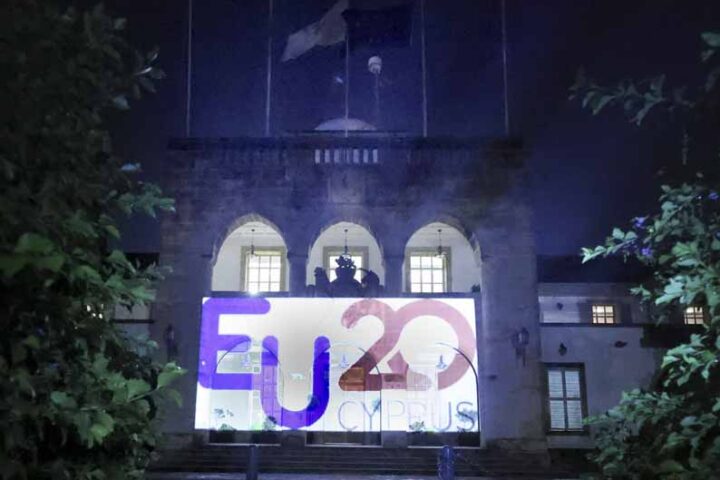.
.jpg) Born-again Cyprus Gourmet, Patrick Skinner, continues his review of Cyprus wine and food
Born-again Cyprus Gourmet, Patrick Skinner, continues his review of Cyprus wine and food
A VINOUS VIEW
.jpg) Whilst I was in Cyprus in March I didn’t taste enough wines to produce an overall picture. I took on what one might term a “reasonable cross-section”. However, two and a half years is not a long time, so probably not a lot has changed. No changes in attitudes, either. As in other countries, some producers pursue a policy of “value added” to their wines by special bottling, labelling and presentation which enables them to ask a higher price. These producers and some others try to move their wines more and more to “international” in style, when perhaps they should be seeking “new Cypriot”. Cyprus wine has now had enough years in which to consolidate its modernity and should be actively seeking more individualism. This is not easy when many of the grapes used are international varieties, vinified with equipment and techniques that are now almost universal.
Whilst I was in Cyprus in March I didn’t taste enough wines to produce an overall picture. I took on what one might term a “reasonable cross-section”. However, two and a half years is not a long time, so probably not a lot has changed. No changes in attitudes, either. As in other countries, some producers pursue a policy of “value added” to their wines by special bottling, labelling and presentation which enables them to ask a higher price. These producers and some others try to move their wines more and more to “international” in style, when perhaps they should be seeking “new Cypriot”. Cyprus wine has now had enough years in which to consolidate its modernity and should be actively seeking more individualism. This is not easy when many of the grapes used are international varieties, vinified with equipment and techniques that are now almost universal.
Alas, the division between wineries run by or using trained oenologists and family or self-taught winemakers still exists. I detect some snobbishness in the attitudes of some of the former, whilst the latter, among whom I would include Fikardos, Constantinou of Pera Pedi and Kiriakides and Kyriakides both of Paphos, proceed on their merry way producing and selling wines in quantity at moderate prices.
Obviously the boutique wineries selling at 8-20 Euros a bottle have considerable competition from imports, many of which are either better wines or better value. Those in the 5-8 Euro price bracket face competition, too, but here the Cypriots offer good value and quality. A great many people who buy wine don’t buy it because they are knowledgeable, but because the wine bottle and label look good, or has been cleverly promoted as “classy”, so well presented wines at slightly inflated prices often succeed.
The criticism I often voiced in the past was that Cyprus wines lack fruit. The reds still do. One or two rosé are quite fruity and I found several whites with good Xynisteri fruit. I have just a few thoughts about some of the wines I drank last month.
RED
AES Ambelis Cabernet Sauvignon: quite often found as a house wine, I enjoyed this several times. It is rounded and well balanced with a clean palate and finish. A good rosé, too.
Zambartas Merlot Blend: a limited edition wine which is very well made, classy almost, with a good balance on the tongue. The Merlot itself is quiet. The wines of Zambartas Père et Fils are quite high priced, but you can always rely on them to provide a good glass and nice match-ups for international/European food.
 Gamekeeper turned poacher? Once upon a time big wine and beer making boss, Akis Zambartas (left) is a happy man at his state-of-the-art Ayios Amvrosios winery.
Gamekeeper turned poacher? Once upon a time big wine and beer making boss, Akis Zambartas (left) is a happy man at his state-of-the-art Ayios Amvrosios winery.
Ayios Onoufrios: first produced in 1996, it was and is a best-seller. It hasn’t changed a lot over the years and it is still a good drink. However, its style is now a little dated and I think the boys at Kathikas ought to be looking closely at a face-lift.
WHITE
 Kolios Persefoni in both dry and medium dry always pleased me, and several glasses of it during our stay confirmed just what good white wine can be made from basically Xynisteri grapes. Ayioklima, from Constantinou was also as remembered, light, good fruit, pleasant on the tongue. High marks to the elegant 2012 Argyrides Chardonnay, expensive at 10 Euros, but good.
Kolios Persefoni in both dry and medium dry always pleased me, and several glasses of it during our stay confirmed just what good white wine can be made from basically Xynisteri grapes. Ayioklima, from Constantinou was also as remembered, light, good fruit, pleasant on the tongue. High marks to the elegant 2012 Argyrides Chardonnay, expensive at 10 Euros, but good.
ROSÉ
I always felt, and still do, that Cyprus needs a strong representation in the rosé sector, not only for its own buffet/mezze table, but to complement the numerous far-eastern food options now available. So, as we ate oriental food a few times and a mixed menu on others we tried a few rosés. I am not one who accepts a blend of red and white wines as constituting a proper “pink” wine and I think those producers who do so should say so quite clearly on the bottle. Accompanying the very high quality Chinese food at Chi (in the Chesters complex at Limassol) a couple of meals were enhanced by the excellent rosé of Tsiakkas, of whom more next week.

Banker turned winemaker, Costas Tsiakkas (left) still has a good financial nose.
More of the people behind the labels and the kitchens next week! Meanwhile, I welcome this contribution from a Cyprus food friend of many years, who wrote reviews for Cyprus Gourmet from time to time.
TWO FOR THE BOOK
Restaurant notes by Charles Dodd
Three of us went to the Four Seasons in Limassol for lunch on Easter Day. The hotel defines itself, with pride and some justification, as the finest in the island. Lunch certainly lived up to the claim. It was the lavish occasion which anyone who knows the Four Seasons would expect: a vast buffet menu for huge numbers sitting outside near the pool, with excellent waiter service, a small band playing and some folk-dancing.
 It was very much a traditional Cypriot lunch on a grand scale: an amazing variety of salads and starters, followed by lamb and chicken from the barbecue, hot dishes from the clay oven, many kinds of vegetables including okra, gigantes beans and oyster mushrooms, then local and exotic desserts, flaounes and coloured eggs. The inclusive price was 54 Euros per person; our bill with only a little wine came to about 200 Euros.
It was very much a traditional Cypriot lunch on a grand scale: an amazing variety of salads and starters, followed by lamb and chicken from the barbecue, hot dishes from the clay oven, many kinds of vegetables including okra, gigantes beans and oyster mushrooms, then local and exotic desserts, flaounes and coloured eggs. The inclusive price was 54 Euros per person; our bill with only a little wine came to about 200 Euros.
One of the selling points for Cyprus as a holiday destination (not sufficiently exploited) is its astonishing variety. It is sometimes suggested that at times in the year you can ski on Troodos in the morning and then go swimming in the sea. Skiing is not an option in April, but one of us has already been swimming at Curium this year.
For no better reason than to try a different venue with the prospect of another excellent lunch, we set off to Lofou on Easter Monday with good memories of previous visits to that picturesque village and of one restaurant in particular.
The Apokryfo is an idyllic place, a beautiful hotel with very good cuisine. The name implies seclusion, a retreat, somewhere hidden away. Fortunately, there are plenty of signs to guide you through the winding streets. After a leisurely drink by the pool, we lunched on tomato and fennel soup, salads and dips (notably the smoked aubergine dip), zucchini fritters, mashed broad beans with wild asparagus and artichokes, lambs’ liver cooked in the pan with onions, then on to the main course of pork souvla and oven-cooked lamb with roast potatoes, finishing with halva and hot baklava for dessert – all for the price of 35 Euros per person.
Which did we prefer? The lavish meal at a five-star seafront hotel or the more subtle lunch in the hills? Two quite different experiences, impossible to choose. But definitely both to try again – and certainly before next Easter.







